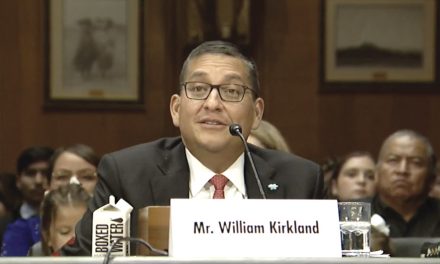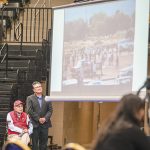
Committee OK’s Nez’s CARES fund bill
WINDOW ROCK
The Budget and Finance Committee was the first stop for President Jonathan Nez’s bill (No. 0116-20) establishing the Navajo Nation CARES fund, and it was approved 4-1 with two amendments.
Even via teleconference, the tension was palpable between committee members and Nez as he was called in to give a presentation.
Only a few days earlier, Nez had line-item vetoed competing resolution CMY-44-20, also known as the Navajo Nation CARES Fund Act — a bill Speaker Seth Damon and a majority of delegates heavily backed.
The line-item veto struck out statutory language, including full paragraphs, of the CARES Fund Act that made the entire statute nonsensical, leading Damon to believe Nez had mangled the bill rather than veto it ouatright, preventing the Council from enacting an override.
“The Navajo Nation Council is moving forward with the best interests of the Navajo People in mind,” stated Damon. “We have acted in good faith and confidence to get all necessary policy and resources together to make the process the best it can possibly be.”
As of Tuesday there were a reported 5,533 COVID-19 cases, 1,960 recoveries and 252 deaths. With a second wave predicted, the Navajo Nation continues to stay closed down for the most part.
As a public service, the Navajo Times is making all coverage of the coronavirus pandemic fully available on its website. Please support the Times by subscribing.
How to protect yourself and others.
Why masks work. Which masks are best.
Resources for coronavirus assistance
Last month, Nez reported the Navajo Area Indian Health Service informed him the peak of infections on Navajo had happened in April. But, although health care facilities are no longer full, the infection rate is hovering at 100 a day.
His main worry was the opening of states and how that could impact the Navajo people and their health, especially since the majority of Diné have been adhering to public health orders of staying home, practicing social distancing, wearing masks, and abiding by curfews.
With this all in mind, Nez told the committee the bill he is backing will direct the $600 million where it needs to go in order to help the Navajo people.
“It is not a settlement, it is monies that were intended to aid U.S. citizens,” said Nez, “and in this $8 billion package, to aid tribal communities throughout the country, to fight off COVID-19. It’s a relief aid, not a settlement.”
The bill also has co-sponsoring support from seven other delegates, including Budget and Finance Committee Chair Jamie Henio and Resources and Development Committee Chair Rickie Nez.
Before any expenditure plans can be made, a CARES fund act, whether it be this bill or Damon’s bill, had to be established and time is of the essence, especially since the Navajo Nation has until Dec. 31 to spend the funds.
“There are immediate expenditures from this legislation before we really get to talk about major projects,” said Nez. “$50.5 million of this $600.5 million would be for the immediate needs to fight COVID-19 on Navajo.”
Listed are personal protective equipment at $8 million; food, water, and basic necessities care packages and related items at $10 million; payroll expenses of $5 million; disinfection of public areas, government buildings and other tribal buildings at $10 million; reconfiguring Navajo offices for safe return of government employees at $10 million; computer hardware and software for Navajo government offices at $2 million; assistance for .638 healthcare facilities at $3 million; expenses to facilitate the procurement and or improving of Navajo financial system at $2.5 million, according to the bill.
“We are at the point of when do we begin to open up our Navajo Nation government?” said Nez. “As we look to opening we need to make sure these government buildings are clean, and some are compromised.”
The bill includes a work group consisting of four members each from the executive, legislative and judicial branches and possibly also chapter representatives to create the expenditure plan.
After committee members called point of order while Nez spoke a couple of times, he asked that they not call a point of order on him as he knowingly went off track a bit from the bill to explain his visit with Secretary of Interior David Bernhardt, and the secretary’s willingness to set aside certain federal regulation and policies to get projects done.
But Budget and Finance Committee member Elmer Begay called for a point of order because Nez was not talking about the bill.
“We are talking about the legislation,” said Begay.
“That’s what I’m talking about,” replied Nez.
“It doesn’t specify anything what he’s talking about,” said Begay. “The agreement or any collaboration he has. If there is an attachment he can attach it.”
Nez ended his presentation there. After this, the bill’s sponsor, Law and Order Committee member Edmund Yazzie tried adding to the presentation but Begay called a point of order on him as well.
“Can we stick to the presentation?” said Begay. “We haven’t gotten to the point. We all know about the data. We don’t need to hear that, we need to stick to the legislation.”
Budget and Finance Committee member Amber Kanazbah Crotty asked about a part of the bill that states the president shall develop and prepare all expenditure plans.
Budget and Finance Vice Chair Raymond Smith asked about the work group.
“If the president is going to develop all expenditure plans then why do we need a work group?” asked Smith. “We are going to take 12 people from their normal tour of duty, responsibilities to create the expenditure plan. Who is their oversight? This red tape. We need to get services out there. We need to expend this money.”
Nez explained the 12-member group will include experts in water lines and electric projects who can immediately start vetting the possible projects to see which ones are shovel-ready.
“These experts would give us a general idea of what projects are ready to go,” said Nez. “What you have seen is previous Council members put into the Sihasiin legislation … projects from their communities, and to this day we don’t have this construction-ready, so they’re sitting there. We don’t want that to happen.”
The committee also wanted to take away Nez’s line-item veto power over any expenditures developed by Council. Line-item veto power was given to the president by the Navajo people through a referendum.
After a couple more hours of debate the bill was approved. The next committee it goes to is Naabik’iyat’I’ and then Navajo Nation Council.








 Highway 264,
Highway 264, I-40, WB @ Winslow
I-40, WB @ Winslow